Spanning two decades (1913 to 1931), Sydney Pollack’s “Out of Africa,” 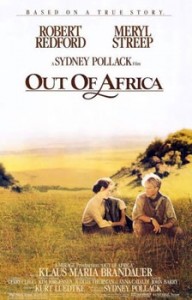 starring Meryl Streep as noted Danish writer Isak Dinesen, is a tedious and rambling rendition of what must have been an exciting life. Streep gives a towering performance as Baroness Karen Blixen (aka Isak Dinesen), a proud woman who contracts syphilis from her husband Klaus Maria Brandauer and then suffers from the non-commitment of her new lover (Robert Redford). But in the end, she achieves a lyrical serenity of spirit.
starring Meryl Streep as noted Danish writer Isak Dinesen, is a tedious and rambling rendition of what must have been an exciting life. Streep gives a towering performance as Baroness Karen Blixen (aka Isak Dinesen), a proud woman who contracts syphilis from her husband Klaus Maria Brandauer and then suffers from the non-commitment of her new lover (Robert Redford). But in the end, she achieves a lyrical serenity of spirit.
The narrative is vague about its heroine’s psyche or soul, providing few clues about the meaning of Africa for Dinesen and how the exotic locale made her the kind of writer and woman that she later became.
Our Grade: B (***out of *****)
Nor does “Out of Africa” work as a passionate love story, for two reasons. Robert Redford’s part, as the white hunter who comes and go as he pleases, is underwritten, and there is no chemistry between him and Streep. For example, the scene in which Redford shampoos Streep’s hair in the outdoors is done in such detached manner that fails to generate any heat.
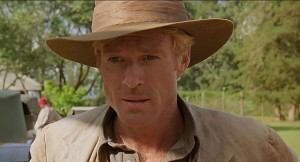 The actors, usually reliable pros, seem too self-absorbed and self-contained to even notice each other. Redford’s interpretation is particularly weak for his interpretation is too contemporary (he doesn’t feel in the period) and he plays his role as yet another of his elusive and detached heroes (his screen specialty). Streep, in contrast, shows virtuosity in completely losing herself, both visually and vocally, in her reveries of remembering her past.
The actors, usually reliable pros, seem too self-absorbed and self-contained to even notice each other. Redford’s interpretation is particularly weak for his interpretation is too contemporary (he doesn’t feel in the period) and he plays his role as yet another of his elusive and detached heroes (his screen specialty). Streep, in contrast, shows virtuosity in completely losing herself, both visually and vocally, in her reveries of remembering her past.
The movie spends too much time dwelling on the colonial mystique of Africa and not enough on the inner life of its main characters. Episodic rather than dramatic, and with cinematography which is beautiful in the manner of National Geographic, “Out of Africa” does have some redeeming qualities. A mature movie about adult characters, made for adult audiences, it stood out from the dominating teenage films at the time.
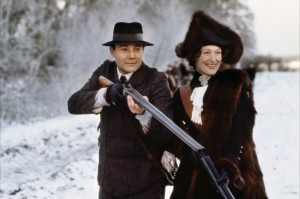 Like “The Color Purple,” the film was nominated for the largest (eleven) number of awards, winning seven, including Picture, Sydney Pollack’s direction, Kurt Luedtke’s adapted script, and David Watkin’s cinematography. (See list below) Both bloated and pretentious, “Out of Africa” can’t decide what it is about, so it goes from the indoors to the outdoor, from melodramatic explosions to exotic settings, but without any dramatic logic as guidance. It’s a diffuse movie of few powerful scenes, and many more that art just distractions for the eyes, several of them involve lion-hunting and shooting.
Like “The Color Purple,” the film was nominated for the largest (eleven) number of awards, winning seven, including Picture, Sydney Pollack’s direction, Kurt Luedtke’s adapted script, and David Watkin’s cinematography. (See list below) Both bloated and pretentious, “Out of Africa” can’t decide what it is about, so it goes from the indoors to the outdoor, from melodramatic explosions to exotic settings, but without any dramatic logic as guidance. It’s a diffuse movie of few powerful scenes, and many more that art just distractions for the eyes, several of them involve lion-hunting and shooting.
Somehow this epic biography about a relatively unknown author, at least to modern American audiences, became both a critical and commercial success, perhaps due to its star power.
Detailed Plot
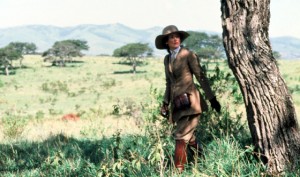 In Denmark, circa 1913, Karen Dinesen, a single wealthy woman, asks her friend, Baron Bror Blixen (Brandauer) to engage in a marriage of convenience. Though member of the aristocracy, Bror is no longer financially secure, so he consents, and the two plan to move to Africa to begin a dairy farm.
In Denmark, circa 1913, Karen Dinesen, a single wealthy woman, asks her friend, Baron Bror Blixen (Brandauer) to engage in a marriage of convenience. Though member of the aristocracy, Bror is no longer financially secure, so he consents, and the two plan to move to Africa to begin a dairy farm.
In East Africa, Karen marries Bror, thus becoming Baroness Blixen. She meets other colonial residents of the country, most of whom are Brits. She also meets and befriends Denys Finch Hatton (Redford), a local hunter. Using her money to purchase a coffee plantation rather than a dairy farm, Bror shows no interest in working, favoring game hunting.
Karen is distressed when learning of Bror’s extramarital affairs, which causes her to contracts syphilis, forcing her to return to Denmark for a long treatment using Salvarsan. Bror agrees to look after the plantation in her absence.
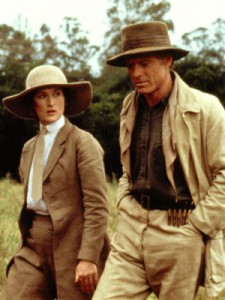 When she returns to Africa, WWI is about to end, but her marriage to the womanizing Bror has not changed, and she asks him to move out. No longer able to have children of her own, she decides to open a school to teach reading, writing, and customs to the African tribal children. Meanwhile, her coffee plantation faces financial difficulties, forcing her to rely on bank loans in order to survive.
When she returns to Africa, WWI is about to end, but her marriage to the womanizing Bror has not changed, and she asks him to move out. No longer able to have children of her own, she decides to open a school to teach reading, writing, and customs to the African tribal children. Meanwhile, her coffee plantation faces financial difficulties, forcing her to rely on bank loans in order to survive.
Despite wish to have a serious relationship, Karen realizes that Denys is as impossible to domesticate. Although he moves into Karen’s house, he criticizes her desire to “own” things, including people, and refuses to commit to marriage or give up his free lifestyle. Karen grudgingly continues in the relationship, knowing it will not ever be official.
The plantation finally yields a good harvest at long last, but a devastating fire breaks out, and the crops and equipment are destroyed. Financially broke, with her relationship with Denys over, Karen prepares to return home to Denmark, just as British East Africa is becoming Kenya Colony.
She sells everything that she owns and empties the house of all her luxurious items. Denys visits her, and the two of them enjoy a drink and a dance. He offers to escort her to Mombasa in his jet in her journey home, and she agrees
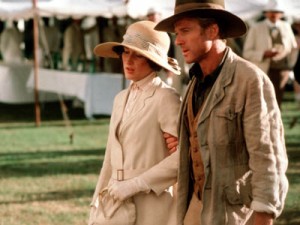 However, Denys never returns, and Karen is told that he was killed when his plane crashed. Karen attends his funeral in the Ngong Hills, and her chief servant Farah takes her to the station.
However, Denys never returns, and Karen is told that he was killed when his plane crashed. Karen attends his funeral in the Ngong Hills, and her chief servant Farah takes her to the station.
Karen later became an author, writing about her experiences in Africa, though she never returned there.
Fashion Alert
The Banana Republic owes Italian costumer Milena Canonero a small fortune. Her Academy Award-winning designs for Meryl Streep and Robert Redford made khaki chic and spawned a far-ranging fashion trend. Newsweek dubbed it “the rugged romantic,” a look that utilized khaki, India cotton and linen in a blend of European high fashion and traditional safari wear.
Oscar Alert
Oscar nominations
Picture
Director: Sydney Pollack
Actress: Meryl Streep
Supporting Actor: Klaus Maria Brandauer
Screenplay (Adapted): Kurt Luedtke
Cinematography: David Watkin
Original Score: John Barry
Art direction-Set Decoration: Stephen Grimes; Josie MacAvin
Costume Design: Milena Canonero
Film Editing: Frederic Steinkamp, William Steinkamp, Pembroke Herring, Sheldon Kahn
Sound: Chris Jenkins, Gary Alexander, Larry Stensvold, Peter Handford
Oscar Awards: 7
The movie won all but four awards: Actress, Supporting Actress, Editing, and Costume Design.











